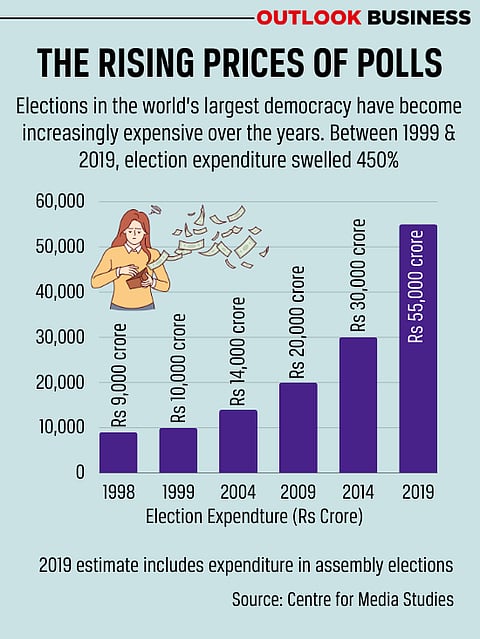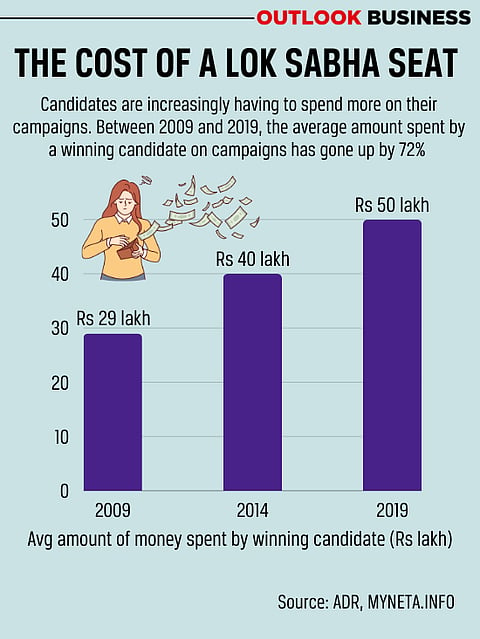Nirmala Sitharaman is the finance minister of the fastest-growing major economy in the world. Sixty-seven years old, Sitharaman spent a significant portion of her professional life in London, where she worked with Pricewaterhouse Coopers (PwC) — one of the world’s largest accounting firms. She joined politics in 2007, became a Union minister in 2017 and only last year, an American publisher ranked her among the most powerful women in the world. Yet, when Sitharaman was asked why she was not contesting the 2024 Lok Sabha elections, she said, “I don’t have that kind of money.”
Gold-Plated Ballots: Why Indian Finance Minister Can’t Afford To Fight Election
Elections in the world’s largest democracy are getting dearer every 5 years. In a country where the per capita income is a little over Rs 1 lakh a year, eight out of every 10 lawmakers are worth a crore rupees or more. The rising costs of the electoral process can alter democracy as we know it
How much money does it really take to contest an election in India? An Outlook Business analysis based on declarations made by candidates to the Election Commission and compiled by the Association of Democratic Reforms (ADR), a New Delhi-based non-profit, of the amount of money spent by candidates who won the 2019 Lok Sabha elections found that an average MP spent around half a crore rupees on their campaign.
An obvious consequence of the rising cost of elections has been a rise in more financially privileged people coming into Parliament. The 17th Lok Sabha, elected in 2019, had 474 MPs with assets worth Rs 1 crore or above, nearly 88 per cent of the House. If crorepatis were a political unit, they would have a majority unseen in Indian polity.
How Expensive are Elections in India Really?
The 2019 Lok Sabha elections were called the “most expensive elections ever, anywhere”. Chances are the 2024 Lok Sabha elections will break that record. Election expenditure in India went up over five times in the 20 years between 1999 and 2019. Around Rs 55,000–60,000 crore was spent on the 2019 Lok Sabha elections. In 1999, that amount was Rs 10,000 crore. Five years later, that cost went up 40 per cent. Between 2009 and 2019, the total expenditure on elections went up by around 175 per cent, according to estimates by the Centre for Media Studies, a Delhi-based media research organisation.
In 2009, an average candidate who went on to win elections had spent around Rs 30 lakh. The next general election's cost went up to Rs 40 lakh. In 2019, the average winner’s spending on elections went up further to Rs 50 lakh. These are just winning candidates’ expenditure on campaigns, and do not include the expenditures made by candidates who lost, or the expenses made from the centralised kitties of political parties.
In India, the Election Commission puts a cap on the amount of money a candidate can spend on their election campaign. As of 2014, that amount was fixed at Rs 95 lakh per Lok Sabha constituency. While a cap exists on spending by candidates, there is no such cap on spending by political parties. The Bharatiya Janata Party (BJP) spent around Rs 755 crore on general party propaganda in the 2019 Lok Sabha polls, not accounting for the amount spent on candidates. The Congress spent around Rs 488 crore on general party propaganda, according to declarations made by the parties to the Election Commission.
Experts say expenditure that candidates and political parties declare is only “the tip of the iceberg”, and actual expenditure is significantly more than declared. “A candidate can be given Rs 95 lakh in cheque and the party can spend several crores and that is legal as there are no restrictions on that,” former election commissioner SY Quraishi told Outlook Business.

Why are Indian Elections So Expensive?
One of the reasons why election expenditures have ballooned over the years is the expanding size of the electorate, says Chakshu Roy, head of legislative and civic engagement at PRS Legislative Research, a Delhi-based non-profit that seeks to make the legislative process more informed. Roy says that when the first general elections took place in 1951, a member of Parliament represented around 8 lakh people. “This number has currently swelled to 25 lakh,” he says.
“The burden of representation per member of Parliament has gone up because the number of seats in the Lok Sabha has remained unchanged since the late 1970s,” says Roy. The number of people a candidate must reach out to has increased, thereby increasing the amount of money required to be spent on campaigns, says Sandeep Shastri, a political scientist and steering committee member of the Lokniti programme of the Centre for Studies in Developing Societies (CSDS).
Candidates have to spend money on handbills, posters, loudspeakers as well as advertising in print, television media and social media. A significant amount of money is spent on campaign workers. Political parties bear part of the expense but in many cases a large chunk of the expenditure comes from the candidates’ own pockets. A study says national parties pass on money to state units specifically for election expenditure. Some advertising on social media and print is paid for by the parties.
The Impact of Expensive Elections
Rising costs of election have led to a sharp change in the fiscal profile of Indian lawmakers. “There is a particular fiscal profile you need to have [to contest elections], and those who fall below the limits that that fiscal profile requires makes you in many ways ineligible to contest elections, because then you are not able to raise the resources that a campaign requires,” said Shastri of Lokniti-CSDS.
In the 2004 Lok Sabha elections, 153 candidates with assets worth Rs 1 crore entered the Lok Sabha. The next general election, 2009, the number of MPs with assets worth Rs 1 crore and above rose to 302. At 58% of the Lok Sabha, crorepatis now formed a majority in the Lower House. In 2014, the number of MPs with assets worth Rs 1 crore or above rose to 442. Roughly 82 per cent of all members of the Lok Sabha were crorepatis. In the 2019 Lok Sabha polls, that number went up to 472. 88 per cent of the people’s representatives were worth Rs 1 crore or more.

The Trouble with Expensive Elections
In a paper published in 2014 by American political scientist Nicholas Carnes titled The Cash Ceiling: Why Only the Rich Run for Office, he said that the economic gulf between politicians and the people who represent them has serious consequences for the democratic process. Carnes’ study, which focussed exclusively on polity in the United States, found that politicians from different economic classes have different views, especially on economic issues.
The study from the US cited above says Americans from different classes don’t usually have harmonious views about the government’s role in economic affairs. “When it comes to things like minimum wage, taxes, business regulations, unemployment, unions, the social safety net and so on, working class Americans tend to be more progressive or pro-worker, and more affluent Americans tend to want the government to play a smaller role in economic affairs.”
Does the same thing follow in India? What’s true of American politics may not be true for India, says Rohit Azad, who teaches economics at JNU. This, according to Azad, is because political parties in India may have a common understanding and no one usually disobeys the whip while voting on policy matters, which is not the case in the United States.
However, Azad adds, “A person’s wealth position as an individual fighting election can influence policy, especially on what they call ‘populist measures’ — a misnomer in my opinion.” What may happen, according to Azad, is that a political party’s position on issues may be impacted because of many relatively rich people representing it who may not have concerns for the poor or the middle class.
A way to circumvent the growing homogeneity in the lawmaking process where the rich get to contest elections is to enhance internal democracy within political parties, says Jagdeep Chokar of ADR. “If candidates are elected by members of the parties, they might not have to spend as much,” he says.
Quraishi says one of the ways of countering the influence of money in elections is to prescribe a ceiling for expenditure of political parties, as is the case with candidates. Another solution, according to him, is state funding of political parties and the setting up of a national election fund where tax free donations can be made.
At the stroke of the midnight hour on August 15, 1947, when one of the poorest and densely populated regions in the world awoke to life and freedom, India was self-assured in resting political power with its millions of uneducated masses. Seventy-six years later, the costs of wielding political power have become so high that Indian lawmaking risks losing out on the perspective of a critical political unit — the ordinary Indian.